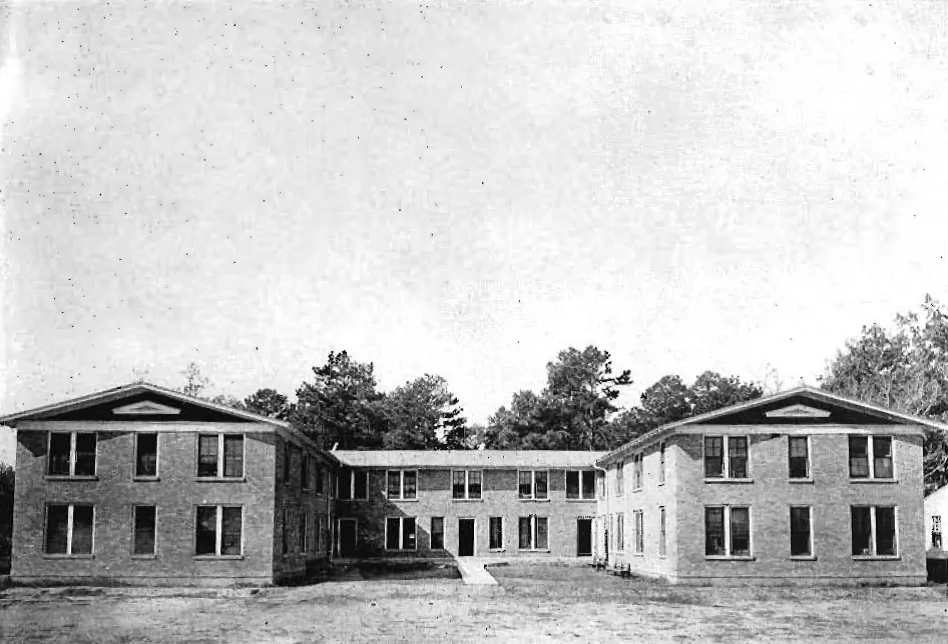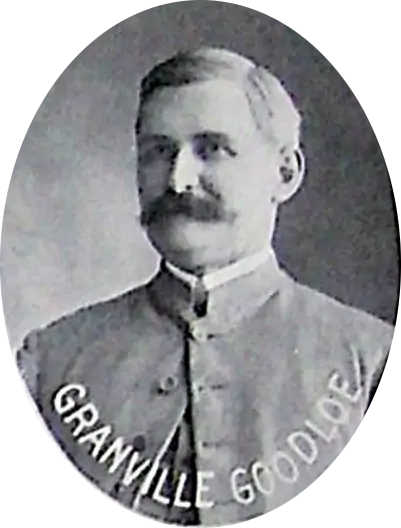Goodloe Hall (1920)

Namesake
Dates
- Built: 1920
- Named: 5/31/1921
- Removed: 2/17/1928 (Fire)
Location Accuracy
- Location approximate based on 1992 plat map, photographs, and description.
Map
History
After the Student Army Training Corps unit was mustered out in 1918 following the end of WWI, the College had used the barracks building as a makeshift dormitory for some of the boys, who called their group "Inmates of the Barracks". Using this building as the north-south base, the College acquired the two buildings constructed for the S.A.T.C. at Ouachita and added each one as east-west extensions of the base unit for a U-shaped structure. The College brick-veneered the entire structure and did other necessary improvements for an attractive building to serve as the Boys' Dormitory.
To construct the dormitory and to pay some of the ever-urgent indebtedness of the College, the Board borrowed $30,000 from John Stark Cargile, president of the Elk Horn Bank and a brother of Dr. Charles Cargile, a charter Trustee in 1890. The Boys' Dormitory was ready for the occupancy of at least 100 men when the Fall Term opened on September 14, 1920.
The College required those living in the Men's Dormitory to "pledge themselves to have no firearms, cards, or dice, and to abstain from every form of rushing or hazing." The young men also furnished pillows, sheets, pillow cases, and cover, preferably "a cover of color and material that will not require frequent washing instead of a white counterpane." The Dean of Men had general supervision of the Dormitory. On petition of the Alumni Association, the Board of Trustees named the new dormitory Granville Goodloe Hall on May 31, 1921, to honor a former faculty member who had died in 1911.
The editor of the Oracle, Aubrey Crawford, had warned students, especially the boys in the dormitory, about the possibility of fire if they did not take proper precautions. The editor cited an incident that almost destroyed the dormitory in December, 1927. A resident on "Thug Hall" left his room door wide open and the open-flame gas heater at full blast. A garment close by caught fire, which soon spread to the "floor of rich pine." A student just happened to pass by about mid-morning, smelled the smoke, and alerted the matron of the Men's Dormitory, Mrs. W. W. Mills. They put the fire out before it could spread beyond the room. But the floor was charred, and "the walls were greatly depreciated in appearance". The editor cautioned the students about the seriousness of the incident and how easily the next one may prove more damaging.
But the warning proved insufficient. On February 17, 1928, about 8 p.m., while most of the students were attending a basketball doubleheader with Hendrix in the Gymnasium, Henderson suffered another calamity when two buildings were destroyed by fire. Goodloe Hall was the first to catch fire, apparently from the flames of an overheated gas stove. Because of the intensity of this fire, the Men's Club House, just to the north of the dormitory, also burned to the ground. This one-story frame cottage had been used formerly as the home of the Dean of Men and his family and later by the Academy boys.
When first discovered by Proctor "Frip" Hill, who turned in the alarm, the fire had gained little headway. Yet, because of "lack of firefighting equipment and the general inefficiency and disorganization which prevailed," the fire had "soon spread beyond control". A high north wind intensified the danger as sparks fell on the other buildings in the vicinity, including the homes of the President, Dr. Shepherd Moore on Tenth and Henderson, and W. E. Barkman, across the street on Tenth Street.
The alarm having reached the gymnasium just before the end of the first half, the game immediately broke up, with Hendrix ahead in the second game, 14-10. Players and spectators rushed to the burning dormitory to save as much as they could. Assisting in "carrying safety the personal belongings of the occupants," students and townsmen braved the smoke—even the co-eds.
But most of the boys were "heavy losers"; nearly all in the north wing lost everything— books, wearing apparel, and other personal effects. Many of the boys "saved some of their property, only to have part of it lost or destroyed by falling sparks". Others saved only what they wore to the game. But fortunately, as in the fire 14 years earlier, no lives were lost.
According to one source, property loss was estimated at $45,000. Valued at $35,000, the building was partially protected by $20,000 in insurance. The loss in the equipment in the building and the personal property of the students was estimated at $10,000. According to the Audit Report, 1928, the loss was set at $28,000 for Goodloe Hall; $4,541 furniture and fixtures, and $500 on the Men's Club House: total, $33,041. The College carried $20,000 insurance on Goodloe Hall; $3,000, furniture and fixtures; $500, Men's Club House.
"Before the walls had scarcely fallen in", President Hornaday had received sufficient offers by the citizens of Arkadelphia, the Caddo Hotel, and Ouachita College, to accommodate twice the number of 75 boys who had been living in the dormitory. Within a week, the old Academy Building became a temporary home for 44 of the boys, with four in each of the eleven rooms. Others found rooms in homes near the campus.
Though classes met as usual on Saturday, several students had to go home "to replenish their fire-swept wardrobes." Two local department stores, Petty and McCormick and J. W. Patterson and Son, sold goods at cost on Saturday to those who had lost their clothing in the fire. Lofton and Power, shoe repairmen, even repaired some shoes without compensation. "All of this goes to prove the real interest the people of Arkadelphia have in Henderson-Brown College and should result in the consolidation of Methodist educational interests in Arkadelphia".
The debris from the ruins of the men's dormitory were being removed to the nearby ravine by September, 1928. Upon completion of the work, the College sodded the debris to enhance the appearance of the east campus.
On January 9th, 1934, Henderson received approval for a loan of $50,000 from the Federal Emergency Administration of Public Works for the construction of a physical education building, which would be located on the former site of Goodloe Hall. The Education Building and Davis-Baker Preschool now occupy the site.
